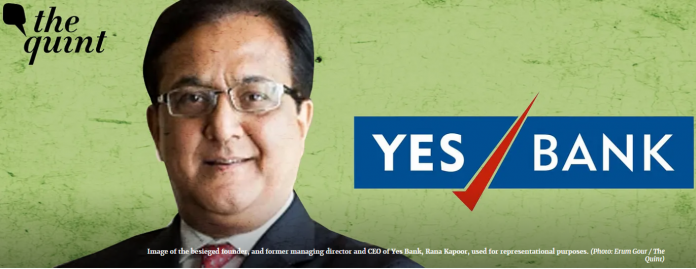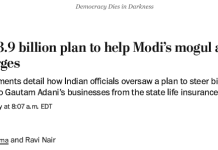AUNINDYO CHAKRAVARTY 20H 14M AGO OPINION5 min read 4.7k ENGAGEMENT
By the time Narenda Modi became Prime Minister of India, it was common knowledge that he was inheriting an economy riddled with bad-loans – loans that banks had given but were unlikely to be repaid. A wide range of numbers were bandied about, running into lakhs of crores of rupees, and the stock market grapevine was agog with stories of dozens of companies that were on the verge of defaulting.
Around this time, Vishal Goyal and Ishank Kumar, two young analysts from the Swiss investment bank UBS, decided to get a firmer grip on the exact level of stressed loans in India’s banking system. But, instead of looking at the data published by the banks, they went directly to the companies.
Also Read : Yes Bank Crisis: Paytm & PhonePe Get Sarky on Twitter
- Yes Bank published revised bad-loan numbers for 2015-16; it turned out to be Rs 4,926 crore – did this finally trigger alarm bells in the minds of the investor community? No.
- Except for a few rare analysts, such as the independent banking expert Hemindra Hazari, no one called out Yes Bank’s façade of being a stable bank.
- What were the RBI and the government doing for five long years, when it had become clear that Yes Bank’s business practices were shady?
Why the Regulator Should Have Hauled Up Yes Bank Management Early On
From the Registrar of Companies (RoC), the two analysts compiled a list of about a hundred stressed companies, and pored over more than 7000 documents that had been filed as collateral to get loans.
What they found, should have shocked the entire investment world. Their data crunching showed that one of India’s darling private sector banks, Yes Bank, had not only continued to lend to several of these companies with dodgy businesses, but had increased its loans to them by 309 percent, between 2011-12 and 2014-15.
On top of that, 19 percent of Yes Bank’s loans had been given to these stressed companies.
Goyal and Kumar stuck their neck out and recommended a Sell on Yes Bank. In everyday parlance, they were telling investors to get out of the bank, saying that if the India’s investment slowdown continues and corporates don’t take loans, Yes Bank would be in deep trouble.
As I said earlier, this UBS analyst report should have shocked investors and Yes Bank’s stock-price should have tanked. The regulator should have hauled up the management and asked them to explain what was going on.
None of this happened. Instead, Yes Bank’s Rana Kapoor continued to win awards for his ‘excellent business acumen and leadership’, mutual funds investing the small investors money in the bank’s shares, and almost every other brokerage kept putting out Buy calls on the scrip.
Also Read : Concern Over Lord Jagannath’s Rs 545 Crore in Yes Bank
Why Didn’t Yes Bank’s Bad & Dodgy Loans Ring Alarm Bells?
Less than a year later, in its 2015-16 annual report, Yes Bank declared that it had bad and dodgy loans of about Rs 749 crore, on its books. This gross NPA (Non-Performing Assets) figure was actually a gross understatement. Prodded by the RBI’s new norms, Yes Bank had to publish revised bad-loan numbers for 2015-16. It turned out to be a whopping Rs 4,926 crore, almost seven times the number it had declared earlier.
Did this finally trigger alarm bells in the minds of the investor community? Not in the least bit.
Except for a few rare analysts, such as the independent banking expert Hemindra Hazari, no one called out Yes Bank’s façade of being a stable bank. Hazari wrote a scathing piece, criticising the Yes Bank management for its lack of transparency and called for action against them for giving a false picture about the bank’s health.
That was in May 2017.
Just like no one acknowledged the UBS report, Hazari’s analysis was also largely ignored. In fact, the Yes Bank stock did remarkably well, even after these warnings. From the time when the UBS report first appeared in July 2015, and well after Hazari’s piece two years later, the Yes Bank scrip rose kept rising till August 2018, when its market capitalization hit Rs 1 lakh crore. And, after that, things went south.
Also Read : What Next For Yes Bank? How Can Its Customers Recover Their Money?
Rana Kapoor’s Exit
News reports began appearing about Yes Bank’s corporate governance issues and how it had hidden its exposure to bad businesses. The bank was desperately trying to raise funds to be able to continue to lend. In the second quarter of this fiscal, Yes Bank made a loss of more than Rs 600 crore. Things were so bad, that the company didn’t even declare its third quarter results. In the meantime, Rana Kapoor sold all his shares and exited.
The question is: what were the RBI and the government doing for five long years, when it had become clear that Yes Bank’s business practices were shady?
Why didn’t it take any tough action against the bank’s management? In fact, why was Yes Bank’s loan book allowed to continue to grow and why weren’t depositors warned that the bank could go under?
Also Read : Deposits Unaffected, Employees’ Salary Assured: FM on Yes Bank
Will Collapse of Yes Bank Change Minds of ‘Pundits’ About Privatisation of Banks?
The government has now nudged SBI and LIC to use tax-payer money to bail the bank out. The authorities are claiming that they have to protect the lakhs of account holders who have deposits worth Rs 2 lakh crore in the bank. In effect, they are bailing out the corporates who have taken these big loans and the management which allowed this to happen.
SBI and LIC are being saddled with a worthless asset, whose net-worth (adjusted for bad and dodgy loans) is virtually zero. Even if the bad-loan issue is fixed at some point, Yes Bank will need deposits to be able to go back to the bread and butter business of lending.
But, why would anyone keep their money with a bank, where withdrawals have been curbed, even if only for a month?
This means the Yes Bank brand is now mud. At best, it can be merged into another private or government bank, and its remaining businesses transferred. Will the collapse of this shining star of private banking make any of our pundits change their mind about the need to privatise all banks? Don’t hold your breath.
(The author was Senior Managing Editor, NDTV India & NDTV Profit. He now runs the independent YouTube channel ‘Desi Democracy’. He tweets @AunindyoC. This is an opinion piece. The views expressed above are the author’s own. The Quint neither endorses nor is responsible for them.)
(Make sure you don’t miss fresh news updates from us. Click here to stay updated )














